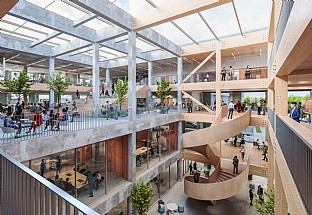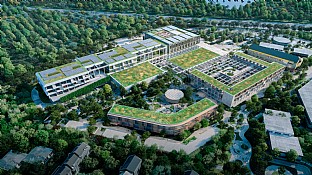The current buildings are a typical warehouse complex that can be found everywhere in suburbs, with warehouses of different heights, loading docks and steel profile facades, surrounded by almost completely paved driving areas and parking spaces. Reusing over 90% of the load-bearing concrete structures, complemented by precise timber construction extensions, creates a powerful narrative of transformation of the site while drastically reducing the ecological footprint.
The tallest part of the logistics centre is transformed into a modern office environment with daylight, communicative atriums, and green terraces, which are created by installing a new wooden floor slab and a four-story wooden front building without major interventions in the existing concrete structure. The front building forms a vertical inner atrium and main entrance and at the same time gives the entire complex a new face from the outside. The facade cladding is self-shading and with the option of integrated solar cells, made from recycled steel profile sheets from the existing buildings.
In addition to the new working environment with associated welfare facilities and showrooms, the project includes a supermarket in a recycled warehouse, designed as a modern market hall without the traditional backsides that free-standing supermarkets often have, as well as functions that benefit the entire neighbourhood, such as daycare, greenhouses and flexible urban spaces for leisure, sports and events. Housing for students and staff will also be integrated into the existing volumes, while some parts of the structure will be converted into exposed columns and beams, which will be planted and become part of the district's new green spaces.
In addition to the new urban spaces and the activities they offer, the project’s parts are connected by an infrastructure and energy concept based on local energy production and storage, with in particular an existing large concrete basement volume offering new innovative possibilities for solar-powered heat pump systems combined with phase-changing energy storage and water reservoirs. In addition, the basement also offers vertical farming and possibly fish farming, to extend the sustainable profile of the entire transformation far beyond the site boundaries.






